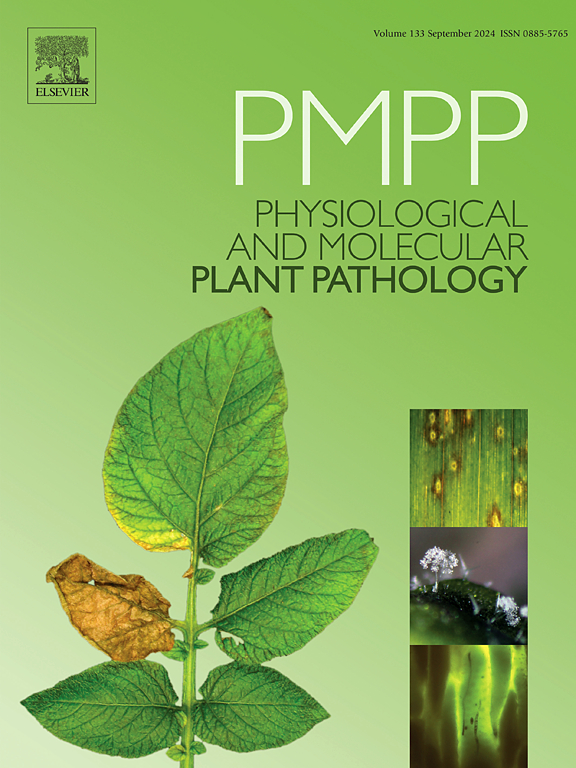建立LSU rrna靶向qPCR检测和防御相关基因的转录谱分析,以阐明大麦对双北极星的抗性
IF 2.8
3区 农林科学
Q2 PLANT SCIENCES
引用次数: 0
摘要
斑斑病是由双星星引起的,严重限制了全球大麦生产。本研究对5株Bolu, trkiye分离株进行了特征鉴定,并采用1-9的疾病严重程度等级筛选了95个大麦品种对最具侵袭性分离株(B_BS01)的抗性。品种Gazda、Dara、Hilal、Nonius和Bravo的抗性最高(疾病严重程度指数为35.00% ~ 36.67%),形成统计学差异组。建立了一种针对sorokiniana病原菌LSU rRNA位点的定量PCR检测方法,可检测低至0.1 pg的病原菌DNA,特异性高。该试验量化了截然不同的定植动态:病原体DNA在抗性品种(Dara, Gazda)中被有效抑制,而在易感品种(Meriç, b本文章由计算机程序翻译,如有差异,请以英文原文为准。
Development of an LSU rRNA-targeted qPCR assay and transcriptional profiling of defense-related genes to elucidate barley resistance to Bipolaris sorokiniana
Spot blotch, caused by Bipolaris sorokiniana, severely limits global barley production. This study characterized five isolates from Bolu, Türkiye, and screened 95 barley cultivars for resistance to the most aggressive isolate (B_BS01) using a 1–9 disease severity scale. Cultivars Gazda, Dara, Hilal, Nonius, and Bravo exhibited the highest resistance (Disease severity index: 35.00 %–36.67 %), forming a statistically distinct group. A quantitative PCR assay targeting the LSU rRNA locus of B. sorokiniana was developed, detecting pathogen DNA down to 0.1 pg with high specificity. This assay quantified starkly different colonization dynamics: pathogen DNA was effectively suppressed in resistant cultivars (Dara, Gazda), while it proliferated rapidly in susceptible ones (Meriç, Bülbül), resulting in up to 15-fold higher pathogen loads by 4 days post-inoculation. Temporal expression profiling of defense-related genes (PR1, PR2, PR3, PR5, PR10, CSD, LOX, PAL) was conducted in Dara and Meriç. Notably, PR1 and PR10 were more strongly induced in Meriç (17.06- and 10.56-fold at 72 h post-inoculation), whereas PR3 was preferentially upregulated in Dara. PR5 and LOX were downregulated in both cultivars; CSD showed moderate induction, and PR2 remained relatively stable. The combination of a sensitive qPCR assay and gene expression profiling provides robust tools for resistance screening and supports targeted breeding for spot blotch resistance in barley.
求助全文
通过发布文献求助,成功后即可免费获取论文全文。
去求助
来源期刊
CiteScore
4.30
自引率
7.40%
发文量
130
审稿时长
38 days
期刊介绍:
Physiological and Molecular Plant Pathology provides an International forum for original research papers, reviews, and commentaries on all aspects of the molecular biology, biochemistry, physiology, histology and cytology, genetics and evolution of plant-microbe interactions.
Papers on all kinds of infective pathogen, including viruses, prokaryotes, fungi, and nematodes, as well as mutualistic organisms such as Rhizobium and mycorrhyzal fungi, are acceptable as long as they have a bearing on the interaction between pathogen and plant.

 求助内容:
求助内容: 应助结果提醒方式:
应助结果提醒方式:


